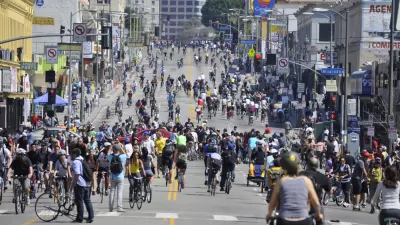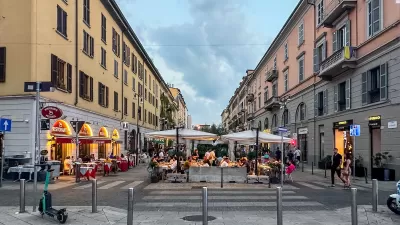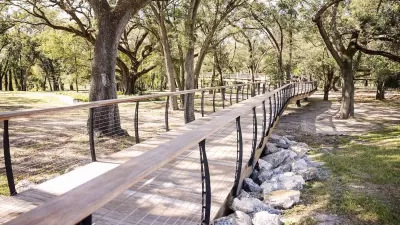An interdisciplinary team of urban designers, architects, and analysts have proposed a neo-retro-futurist scenario for making downtown Portland nearly car-free by 2050.
Portland may be taking a nod from Los Angeles' 70's-era planning history to make future development in their downtown area car-free, or almost car-free by 2050. Yesterday, the urban planning and policy blog Hugeasscity reported on a GGLO proposal to repurpose the city's historic Memorial Coliseum building, located at the perimeter of the downtown core, into a colossal automated park and ride.
In typical Portland fashion, however, there is a Green-ish twist. Instead of cementing a future of auto-dominated travel, the building will become the opening salvo in the car's ultimate retreat from the City. At first, the park and ride (called a "mobility hub") will serve as a redevelopment catalyst – freeing most new construction in the downtown core from the financial and spatial burden of providing parking, thereby enabling increased overall density and affordability. Very much like a giganto-scaled version the "Park Once" garages that supported the recent revitalization of the 3rd Street area in Santa Monica and East Colorado Boulevard in Pasadena, or a modern reinterpretation of LA City's 1970 plan that located massive parking structures on the 101, 110, 5, 10 loop around downtown. The big difference here is threefold: Portland's garage will be 500 feet from high-quality regional rapid rail and bus transit, it's 5200-car capacity would be a civic spectacle in and of itself, and it's use as a garage that facilitates auto travel would sunset. After 40 years, when urban density and vibrancy have increased to the point that cars as we know them are obsolete, the building will become a car memorial museum. With the push of a button, visitors could "order up" any one of the 5200 cars stored in the collection, and it would be delivered to their feet for viewing.
The Coliseum "mobility hub" would be one of a series, whose modular automated parking units could be disassembled or repurposed when density near the core increases, and reassembled farther out to catalyze compact development elsewhere.
The proposal is an audacious response to the 2010 Rose Quarter "Call for Concepts" and to Portland's bold 2009 Climate Action Plan, which requires an 80% reduction of GHG emissions by 2050, when population is forecast to have grown by 90%.
FULL STORY: Coolest Park and Ride Ever

Planetizen Federal Action Tracker
A weekly monitor of how Trump’s orders and actions are impacting planners and planning in America.

Map: Where Senate Republicans Want to Sell Your Public Lands
For public land advocates, the Senate Republicans’ proposal to sell millions of acres of public land in the West is “the biggest fight of their careers.”

Restaurant Patios Were a Pandemic Win — Why Were They so Hard to Keep?
Social distancing requirements and changes in travel patterns prompted cities to pilot new uses for street and sidewalk space. Then it got complicated.

Platform Pilsner: Vancouver Transit Agency Releases... a Beer?
TransLink will receive a portion of every sale of the four-pack.

Toronto Weighs Cheaper Transit, Parking Hikes for Major Events
Special event rates would take effect during large festivals, sports games and concerts to ‘discourage driving, manage congestion and free up space for transit.”

Berlin to Consider Car-Free Zone Larger Than Manhattan
The area bound by the 22-mile Ringbahn would still allow 12 uses of a private automobile per year per person, and several other exemptions.
Urban Design for Planners 1: Software Tools
This six-course series explores essential urban design concepts using open source software and equips planners with the tools they need to participate fully in the urban design process.
Planning for Universal Design
Learn the tools for implementing Universal Design in planning regulations.
Heyer Gruel & Associates PA
JM Goldson LLC
Custer County Colorado
City of Camden Redevelopment Agency
City of Astoria
Transportation Research & Education Center (TREC) at Portland State University
Camden Redevelopment Agency
City of Claremont
Municipality of Princeton (NJ)





























